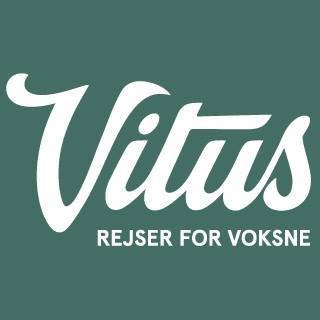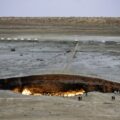Estonia and Latvia – with history as a travel companion is written by Jens Skovgaard Andersen.

The Baltics live with the memories of war
Estonia and Latvia have a close connection to Scandinavia. This is not least due to the close historical ties from the time when Denmark og Sweden ruled in turns all around The Baltic Sea. The historical ties go back a long way, but also in recent times the Baltic countries have been decisive for the development of history both for them and for us.
It was in Estonia that the nuclear missiles were ready København and Denmark as targets, and in Latvia were the large radio telescopes that eavesdropped on everything that happened on land, at sea and in the air. And after the fall of the Iron Curtain, it was not least with the help of pressure from Scandinavia that the Baltic countries were pulled out of the Soviet Union and into the West.
When you travel to Estonia and Latvia, you are constant close to the story - not least the history of war - from the past hundred years. From the Russian Empire and the First World War to the Wars of Independence to the Second World War battles and occupation from both the German and Russian sides to the Cold War. Here was Baltic states front line of battle to the west and thus towards us in Denmark.
There are an incredible number of fascinating and also terrifying stories all over Estonia and Latvia. Although they can be difficult to find at first glance, they are worth exploring. With a little curiosity and a little help from the locals, a really exciting journey awaits you through both the pleasant highlights of today and the terrible tales of the past.

Riga – Latvia's cozy capital with a dark heritage
It is obvious to start your journey in Riga, which has good air connections to the surrounding countries, including Denmark. Getting around Estonia, Latvia and the southern neighbor is easy Lithuania either by car or e.g. by bus from Riga's bus station. The bus station is right in the center next to the large market in the old zeppelin halls, which are clearly also worth a visit.
You can easily spend several days exploring both the cozy old town and the more modern neighborhoods on both sides of the Daugava river. Enjoy life with a coffee at a sidewalk cafe and some good local food – and also delve into the darker side of Latvia's history.
Feel the dark history
At the Occupation Museum in a very Soviet-style building, you can follow the tumultuous history of modern Latvia through war, uprisings and occupation up to what Latvia is today. It is easy to spend hours reading, seeing, hearing and feeling how the winds of history have blown through the country to such an extent.
The exhibition is brand new and it is really well done. If you take the children with you, it can get a bit violent in some places, but there is also a lot to learn with the right adult at hand.
It becomes even more gloomy in the 'Corner House', as the old KGB headquarters is called. The house was taken over by the KGB's predecessor, the Cheka, and it was here that you could be summoned to a meeting without knowing what the meeting was about. And many did not return home from there.
With a guide, you get the whole grim story of the house and visit both the prison cells, the interrogation room, the backyard and what's worse. It's a tough game.
Cheka is also the short version of the less colloquial official name, which in English is "All-Russian Extraordinary Commission for Combating Counter-Revolution and Sabotage under the Council of People's Commissars of the Russian Soviet Federative Socialist Republic".
Discovering the history of Latvia - excursions from Riga
With Riga as a starting point, you have a number of good excursion destinations within a short driving distance. If you want to explore the military history of the area, you might want to visit the organization Military Heritage Tourism website, where, among other things, you will find one really good interactive map with hundreds of military sights.
On the northern edge of Riga, you'll find the Mangaļsala peninsula, which is dotted with old abandoned bunkers and gun emplacements from the many wars of the 20th century. It pays to have a guide with you to get the most out of the visit, but otherwise the forest area is perfect for exploring.
Because the coast was off-limits to anything but the military during the Cold War, the beaches are nice and unspoiled, so pack a swimsuit if you're there in the summer. In fact, the Baltic coast here is almost a long sandy beach, which, apart from a few swimming-loving soldiers, has been allowed to fend for itself for decades.
One hour north-east of Riga lies the small, unsightly town of Ligatne, which, with its street love and the old paper mill, oozes adventure and idyll. You will find a stark contrast to this glossy image underground.
A Soviet-style recreation home on the outskirts of the city hides a very well-kept secret: an underground bunker that would house Latvia's top leadership if war broke out. It was supposed to last 3 months, but it has only been tested for 3 days.
The bunker is complete with command room, ventilation center, washing room, canteen with Soviet delicacies and is altogether a time warp from the Cold War, which should fascinate both old and young guests.

Top secret telescope and Brezhnev seaside resort
A slightly longer excursion 2½ hours' drive to the west takes you to Ventspils, which could also easily be worth an overnight stay on the journey. Be aware, however, that the accommodation options in the city are limited, as tourism has had a hard time with industry and especially the oil industry for decades.
As a tourist town, Ventspils has a somewhat tarnished reputation compared to, for example, tourist-friendly Liepaja a few hours to the south, and that's really a bit of a shame. The town is actually pleasant, and the old castle in particular bears witness to the merits of the past, as Ventspils was an important port in the Middle Ages. Later, oil took over, and now a new adjustment awaits ahead.
A fun way to experience the city is by going on a cow hunt. All over the city you will come across cows – or sculptures of cows – each with its own colorful theme. Happy cow hunting!
30 kilometers north of Ventspils, far out on a deserted road with fir trees on both sides, as far as the eye can see, you come across yet another secret. Here stands the large radio telescope, which had the task of eavesdropping on the enemy. It was abandoned by the Russian troops in 1993 and is now taken over by science.
The small museum in a building close to the telescope appears a bit messy and haphazardly arranged, but there are lots of exciting and funny stories from a time when the telescope and the listening station officially did not exist. The base was top secret and all life took place on the base. On special occasions, however, the soldiers were allowed to go into town in Ventspils, and it was quite a sight for the locals when the non-existent soldiers from other Soviet republics suddenly trooped up and went to the nightlife.
In the museum, between a collection of beer cans and a rusty enamel sign with a red star, hammer and sail, a series of picture collages are arranged. The pictures are, among other things selfies taken by the soldiers who lived on the base until the end of the Cold War, and the many personal photos give a particularly intimate insight into daily life on the base.
Persistent rumors say that the listening soldiers could point the telescope in the direction of Western radio stations to hear music - and when you feel the isolation far out in the forest, you can easily understand it.
The telescope itself and the associated measuring devices are manufactured at a submarine factory in Ukraine, and it's fun to see how marine machine parts have been used for new purposes. Ingenuity was great during the war.
There is a lot to explore if you get here first. In addition, there is no mobile signal within a 9 kilometer radius to keep the radio signals free from interference, so it may well be an ordeal for most modern people.
Just to the west of Riga itself lies the seaside resort of Jurmala, which was a favorite haunt of the highest authorities in the Soviet era. This is where Khrushchev and Brezhnev vacationed. In reality, Jurmala is a lot of small seaside towns, which have grown together along a 30 kilometer long sandy beach, and this is where the beach life is lived to the fullest during the day and the nightlife to the fullest at night.
Take a walk on the beach, eat some good local food and enjoy life as both the Latvians and their neighbors have done for many decades in laid-back Jurmala.

Travel to Estonia – idyll and nuclear missiles
We Danes probably mostly associate Tallinn with Dannebrog and medieval coziness, and there is good reason for that. Tallinn is charming and historic, and it's tempting to linger here and not move on around the country. But that would be a shame; there is a lot to see if you travel to Estonia.
An hour from Tallinn with views over the water to Finland is an abandoned submarine degaussing base that you can visit. And you can even spend the night in small cabins – glamping – with a view of the water, the base and the sunset. And during the day you can cycling, hiking, paddling and rowing around the beautiful natural surroundings. It hardly gets any better.
The submarine base is located in the small Hara harbor in peaceful surroundings, which almost makes one forget the heavy past, as the concrete structure left behind bears witness to. Graffiti artists and birds have moved into the old base and the plan is to turn it into a gallery. So far, however, it is a concrete and visible example of Estonia's major role in the Cold War.
Further east on the way to Narva and the border Russia the cold war becomes very clear and thought-provoking. Not least for us Danes. Out in the forest, far from the beaten track, stand the old hangars that housed the nuclear missiles aimed at western targets.
The range of the rockets was approximately 2000 kilometers, and that was just enough to reach London and almost too Paris. A closer target was Copenhagen, and it is natural to think that at least one of the rockets had Copenhagen's coordinates entered if the nuclear war came. The rockets could be fired in 4 minutes, after which the base would be abandoned and left behind as an empty mega-sized cartridge case.
Nowadays there is not much to see apart from the large hangars in the forest in Kadila and Rohu, but with a local guide it is an experience that leaves a mark. The war was close, and it was not so long ago that the world was completely different; it is clearly felt here.
Estonia, like most other former Soviet republics, is littered with war monuments from the wars of the 20th century. They stand in squares and squares, in roundabouts and along roads, and it is worth stopping and taking a closer look at them. It is part of the experience if you travel to Estonia.
Whether they will be allowed to stand for posterity is doubtful, and a great deal of work is underway to secure the monuments that may be removed.
Island hop with a military feel and beach holiday for the whole family
Out on the island of Hiiumaa, west of the Estonian mainland, you will find a military museum where you can really feel the past and touch the history of war. The owner of the museum collects all the war material he and others can find, and he is also ready to accept the statues and monuments that are taken down elsewhere.
The Hiumaa Military Museum is truly a fascinating place where children of all ages can tinker and touch, and where the changing history of war is kept alive. But that's not the only reason to go to Hiiumaa.
The island was the first redoubt in the war, and for decades it was not allowed to visit Hiiumaa without special permission, and such permission was not very often obtained. Therefore, much of nature is untouched, and so are the military installations that the island's coast was full of.
Lookout towers, lighthouses and gun emplacements stand as they were abandoned – however, the precious metal of the cannons has often been reused for other purposes. At the same time, the quiet and peaceful island life is lived, as it is lived on countless other islands around the world - here there is no stress and rush, and there is plenty of time to enjoy local beer and local delicacies.
You can sail to Hiiumaa from either the mainland port town of Rohuküla or from the larger neighboring island of Saaremaa to the south. You can also fly by propeller plane from Tallinn to Hiiumaa's tiny airport at Kärdla on the north side of the island. The short flight and the airport on the island is an experience in itself.
If you are traveling to Estonia and want sand between your toes and your heart rate down to a resting level, then you should visit the seaside resort of Pärnu, which is located on a quiet bay just two hours south of Tallinn and is the fourth largest city in Estonia. Although Pärnu is a historically important city full of stories, it is clear to feel that it is the beach that draws.
In the old days it was spa and mud bath, which attracted the guests. Due to the shallow warm water in the bay, it is now often families who head towards Pärnu to recharge their batteries, but the town is definitely for everyone with a penchant for relaxation.
If you want to experience Pärnu from its most untouched and adventurous side, then you should consider staying at Villa Ammende, which is like something out of a fairy tale. They also hold concerts in the garden, which are open to everyone, so you can easily come and visit, even if you live elsewhere in the city.
Estonia is much more than Tallinn, And Latvia is much more than Riga. There are enough activities to keep the whole family busy on holiday. You get the best combination of relaxation for the body and exercise for the brain when you travel to Estonia and Latvia. You will definitely come home full of impressions.
See much more about travel to Estonia, Latvia and Lithuania here
Have a great trip and have a great time!




















































Add comment